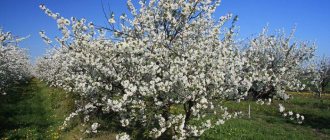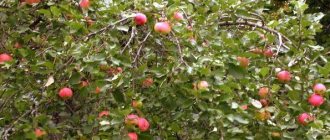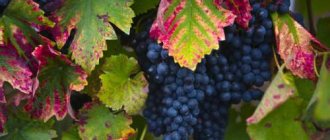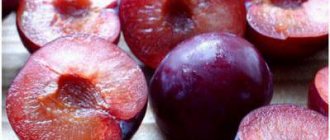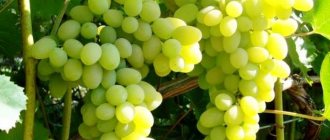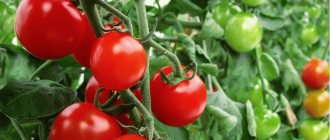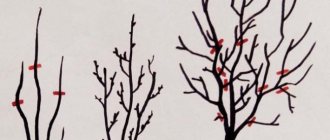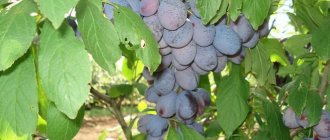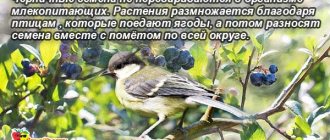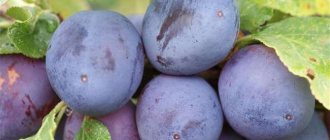What varieties of plums grow well in the Leningrad region
Good health, good harvests and good mood, dear gardeners! Just returned from a short trip. I was visiting a childhood friend who ten years ago went to visit her daughter in the Leningrad region, and stayed there. She and I talked a lot and discussed a topic that was important to us.
A friend of mine is a gardener by vocation. She boasted about new seedlings that had just begun to bear fruit. I really envied her when I saw what kind of fruit she was picking from the branches. So, plums for the Leningrad region - varieties and their advantages. I’ll tell you about everything I saw with my own eyes or heard.
Rules of care
Planting a seedling is only part of the work done. It is important to remember that every plant needs complete and high-quality care. Watering is carried out according to certain rules.
- You can water only in the morning or evening so that the sun's rays do not evaporate moisture from the soil.
- You can only water with warm water, as it is better accepted by the roots.
- Watering interval - once every 7-10 days.
- At least 10-20 liters of water are poured under each tree.
Feeding is carried out several times during the entire growing season. The first, using potassium and nitrogen (20 g of ammonium nitrate and 30 g of potassium nitrate per 10 liters of water) is carried out before flowering begins. The second feeding (dilute 40 g of superphosphate in 10 liters of water) is carried out 10 days before fruiting.
10 days before fruiting, the plum must be fertilized with a superphosphate solution
Endurance and unpretentiousness
Have you been to St. Petersburg? If yes, remember what the sky is like there. Usually gloomy, gray. It rains often. Due to high humidity, gardens are more susceptible to rot and other fungal diseases.
Severe winters also pose a danger. Where dachas are located close to the forest, animals may chew on the bark in winter. Therefore, growing plums involves using only hardy, winter-hardy, best varieties with early ripening. Priority is also given to samples with compact, low crowns - gardeners, as elsewhere, save space.
Taking into account the climatic characteristics of the North-Western region, it is advisable to grow several related self-fertile trees on the site at once. Firstly, they will become pollinators for each other. Secondly, with different ripening periods, they will provide the family with fruit for the summer and autumn.
Alyonushka
The self-fertile variety Alyonushka is characterized by early ripening - 100 days after flowering.
The tree can reach a height of 2 m. The crown is pyramidal in shape, its density is average. The leaves of this plum look a little like peach leaves. This variety is self-fertile, so the Russian Economic and Chinese Self-fertile varieties, which are pollinators, should be planted next to it.
The fruits can reach a weight of 40 g. The shape is round. The color is dark red, without impurities. The flesh is medium dense and has a rich orange tint. The taste is sweet, with a slight sourness. The stone, which weighs 1 g, is quite difficult to separate from the pulp. The fruits ripen in mid-August.
The best choice
Which plums received the attention of Leningrad summer residents? Based on reviews, based on my friend’s personal experience, I can give successful examples.
- Red early ripening. A “folk” tree, it is almost impossible to establish the authorship of the breeder. The fruits are small (up to 20g), oval-shaped, reddish with a bloom. The pulp is dry and dense. The taste is a solid B. The bone comes off well. One of the first to bear fruit.
- Early ripening is round. An old selection variety. Ripens early, the fruits are red-bluish, small (no more than 12g). The advantages include an easily separated seed, a rich sweet and sour taste, excellent winter hardiness, and high adaptability to adverse weather conditions.
- Renkold collective farm Michurin selection. It is widespread not only near St. Petersburg, but also in the Middle Zone in general. The height of mature trees is average, the fruits when ripe gain weight up to 20g, are round, yellow-green with a dense peel. Excellent winter hardiness.
The characteristics of the samples I have named are their popularity. By planting any on your plot, you can achieve high, sustainable yields without much hassle. Another plus is that for all varieties, Skorospelka red is the best pollinator. Even if it does not grow on your site, your neighbors will probably have such a tree.
Collective farm farmhouse
This variety is often called yellow cherry plum. It is ideal for growing in the Leningrad region. Its main advantages include the following parameters:
- frost resistance;
- the ability to quickly recover from stress;
- disease resistance;
- excellent taste.
Renklod collective farm plum has an excellent taste
Among the main disadvantages, only the property of self-sterility is distinguished. For this reason, pollinator plants should be planted next to this tree. The Moscow Hungarian and the Russian Kolkhoz Woman are considered ideal options.
The tree grows up to 4 m. The crown is wide, oval in shape. The fruits are medium in size, weighing up to 40 g. The taste is pleasant, sweet, without bitterness or sourness. The pulp is juicy, but not watery, yellow-green in color. This yellow plum is suitable for all-purpose use. It can be eaten fresh, used for making desserts or winter preserves.
We invite you to read: Description and use of an unusual variety of bird cherry Colorata
Growing rules
In order for plum trees to take root in the Leningrad region, planting and care must be carried out correctly.
- Choose a place for planting that is illuminated and well-warmed by the sun's rays. Pay attention to the composition of the soil. Light, fertile soil with good drainage is suitable. It is not recommended to plant seedlings in swampy areas for this purpose.
- Pruning of young growth is done with care. Active attempts to thin out the crown usually lead to the opposite result: dormant buds awaken, which produce a mass of new shoots. But it’s worth taking care of supports for branches during the fruiting period in advance.
- When to plant – in spring or autumn – is a fundamental question. A friend says that in their climate it is most reliable to place young seedlings in a permanent place in the spring. But she also has positive “autumn” experience. Only in winter she wraps young trees especially carefully. However, he applies the same measures to columnar varieties, constructing real “houses” over the trees. Covers the tree trunk areas with straw and compacts the snow around.
- The tree needs feeding at the initial stage. A nutrient mixture (humus mixed with soil) is added to the hole dug for the seedling. Subsequently, from the beginning of fruiting, regular annual feeding with mineral and organic substances is sufficient. In the tree trunk circle, the earth is dug up to a shallow depth with humus, superphosphate, potassium sulfate, and ash per square meter: 10 kg, 60 g, 20 g, 200 g, respectively.
And the last thing my friend talked about. Early high whitewashing helps to stop flowering when there is a threat of spring frosts. And if the temperature drops completely unexpectedly, a friend lights a fire in the garden. Moreover, he specially places damp firewood so that more smoke comes out. This saves the kidneys from frost. Thanks to this, there are always plums on her table, as well as cherries, apples and pears!
This is where I end my story, dear like-minded people, and say goodbye to you. Are there any gardeners among you living near St. Petersburg? It is very interesting to know your opinion. Share information about promising varieties for the Leningrad region here and on social networks, and I will send the link to my friend. I hope she enjoys participating in the discussion!
Propagation of cherry plum seedlings
This method is considered more time-consuming. In addition, it has other disadvantages - for example, the loss of varietal characteristics of the plant whose fruits were used to obtain seeds. However, some gardeners believe that despite this, the taste and yield are often superior to the mother plants.
Read more: Ural ruby cherry variety description
Before winter, they should be sown in beds or boxes with an interval of 4-6 cm between sowings, and 18-20 cm between rows. The crops should be well watered and mulched with a layer of sawdust or peat 2-3 cm thick. If the seeds are sown on bed, then, with the arrival of winter, snow is added on top of the mulch. During the winter they undergo natural stratification, and by spring they emerge. The resulting seedlings can be grafted only after a year.
To do this, you should buy only local specimens that are grown in the same conditions in which mature trees will grow, which means adaptation to the soil and climate. Both self-rooted and grafted cherry plum seedlings are available for sale. The latter were obtained by grafting cuttings onto a rootstock.
Potted seedlings with capped roots are planted after the threat of frost has passed. Bare-rooted seedlings are planted before buds open in the spring. The upper part of the seedling must be cut to a height of 20-30 cm. Planting holes are prepared in the same way as for other fruit crops. Potassium, phosphorus, and organic fertilizers are added to the soil.
Plum for the Leningrad region - The best varieties
Plum is one of the most beloved and widespread fruit trees in our country. Despite the good viability, when selecting plum varieties for the Leningrad region, it is better to give preference to species adapted to this region.
To simplify the selection of the desired variety, the zoning method is used. The Leningrad region, together with the Vologda, Pskov, Tver, Kaliningrad, Novgorod, Yaroslavl, Kostroma regions and Karelia belongs to the North-Western region, which is listed in the State Register as No. 2.
The conditions of the region are quite harsh - frosty winters, high humidity, frequent winds, lack of sun. Therefore, plums for the northwestern region must be winter-hardy, resistant to sudden changes in weather, diseases, especially fungal ones, and not very demanding on the composition of the soil.
Note! When choosing a plum for the northwest, self-fertile varieties should be chosen. An alternative is to plant several plum trees of other varieties to achieve cross-pollination.
Plum for the Leningrad region - The best varieties
The best option for special climatic conditions is a compact tree with good frost resistance, the ability to recover if the buds freeze, and resistance to fungal diseases, which often develop due to waterlogging of the soil.
Fortunately, the variety is quite wide - from old, time-tested to new, still little-known species, but which have already earned many good responses.
The best plum varieties for the northwest and their descriptions
Early:
- Red early ripening. One of the oldest subspecies, which has retained its popularity to this day. Bred by folk selection, it is valued for its stable productive yield and early ripening period. The fruits are quite large - up to 20g in weight, round. The skin is dense, pale pink in color with a slight waxy coating. The pulp is light, dense, not very juicy. The taste is sweet, the aroma is unexpressed. The bone is small and easily separated. Plums are suitable for fresh consumption and processing. Winter hardiness is high, but there is a threat of freezing during spring frosts. In most cases, the tree is restored. The plant is self-fertile, but in the presence of a pollinator the yield increases.
- Early ripening is round. Another representative of an ancient species. It serves as the basis for the development of many new improved varieties. It is distinguished by its excellent adaptability to various climatic conditions, with a yield of up to 140 centners per hectare. The fruits are small - up to 12g, round in shape, rich blue-violet color. The pulp is yellow-orange, juicy, the taste is sweet and sour, with a pronounced plum aroma. Universal in use, easily transported and stored. The plant is self-sterile.
- Alyonushka. A bright representative of the Chinese plum. It is distinguished by a shape of shoots and leaves unusual for our country - in appearance it is more similar to a peach tree, reaching a height of 2.5 m. It is characterized by good resistance to diseases (clusterospiriosis, moniliosis). This table variety has earned its popularity due to its excellent quality. The plums are very large, massive - reaching 40g in weight, round. The color is a beautiful rich pink, almost red. The middle is bright orange, not too dense, but very juicy. The taste is wonderful, sweet with a slight sourness. The bone is not large, but is difficult to remove. Quite a new variety for our latitudes, average flowering time, self-sterile. The bark is highly resistant to freezing. The harvest can be harvested from mid-August.
- Volga beauty . Very popular due to its excellent yield parameters and fruit quality. The plant is tall and grows quickly. The fruits are large, weighing 30-40g, round, slightly flattened at the base. The skin is dense, red-blue with a rich coating, and easily peels off. The stone is medium, easily separated. The pulp is light orange, soft, juicy, with a balanced sweet and sour taste. It is characterized mainly as a dessert variety, but is quite suitable for processing. It can withstand transportation only if the crop is harvested in a state of technical maturity. The age of fruiting is 4 years; it bears fruit in full force starting from the 6th year after planting. Productivity is stable and high. Self-fertile, but in the presence of pollinators, it appears much better. Another feature of this variety of plum is its method of propagation - using cuttings. In the spring, the pagon is grafted onto the rootstocks of Skorospelka red. Requires light soils, sunlight, and constant crown formation. High winter hardiness, not affected by diseases, rarely suffers from pests, but can sometimes be endangered in the form of plum moth or cherry elephant. Does not tolerate root soaking well.
- Eurasia 21 . A promising, highly productive hybrid, the result of crossing domestic plum, cherry plum, American and Chinese plum. Bred at the Voronezh Scientific Research Institute and entered into the State Register in the late 80s. The tree is large, with a spreading crown. It is characterized by the endurance of roots and flower buds to low temperatures and thaws. The fruits are medium compact in size - up to 30g, dark cherry color with a blue waxy coating. The pulp is dense, juicy, bright orange. The taste is pleasant, refreshing, sweet and sour with a light plum aroma. The bone is small and difficult to separate. Transports well and stores well. It is defined as a table variety, but is often used for making juices and canning. The plant is self-sterile. Good pollinators are Rencold kolkhoz, Rencold Kuibyshevsky. Fruits from the 4th after planting. Productivity is good and increases significantly under favorable weather conditions. Requires careful crown formation.
Mid-season:
- Emma Lepperman . High-yielding subspecies of Western European selection. The plum tree has taken root especially well in Karelia and the Kaliningrad region. The tree grows profusely and requires constant pruning. Responds to additional care and feeding. Loves loamy fertile soils. Under favorable weather conditions, the yield can be more than 250 centners per hectare. The fruits are large - up to 45g, round in shape. The skin is strong, beautiful yellow with pale pink sides. The pulp is pale yellow, juicy, crisp, rich in taste and pleasant aroma. The seed is large and easily removed. Requires cross-pollination.
- Gift to St. Petersburg . It is a hybrid of Chinese plum and Pioneer cherry plum. Medium sized plant. The fruits are small, weighing 10-15g, oval in shape. The skin is thin, bright yellow in color. The interior is dense, rich yellow in color, has a refreshing taste and pronounced aroma. The fruit is universal in use, tolerates transportation well, and is characterized by good keeping quality. High and stable productivity, adaptability to various weather disasters. A pleasant feature is that the tree is able to regenerate itself after the buds freeze and withstands thaws. Another advantage is early pregnancy. The tree begins to bear fruit by the age of 3.
- Edinburgh . A well-known variety of Western European origin. The tree is tall, the crown is branched. The fruits are large - up to 35g, round in shape, dark red or red-violet in color. The pulp is crispy, juicy, green-yellow. The skin is strong and not prone to cracking. It is valued for its high yield - up to 250 centners per hectare. An excellent feature is the self-fertility of the culture.
Late ripening:
- Ochakovskaya yellow (Livlyandskaya yellow egg). One of the oldest subspecies of Baltic origin. Medium sized plant. The fruits are small - up to 22 g, yellow with a greenish tint, oval in shape. The pulp is pleasant yellow in color, tender, sweet. The bone is small and difficult to separate. Good resistance to frost and disease.
- Hungarian Pulkovskaya . A long-known variety that continues to be planted throughout Russia. According to its parameters, it perfectly suits the characteristics of the north-west. The plant is tall, resistant to soaking and frost. The fruits are medium-sized - up to 25g, dark red or dark purple in color, round. The pulp is dense, yellow, with a clearly noticeable sourness. Tolerates transportation well. Used for canning, making jams and juices.
Interesting! The achievements of modern selection allow gardeners to make the correct and most suitable choice of planting material. Such old and proven varieties as Rencold Kolkhozny, Rencold Kuibyshevsky, Victoria, Orlovskaya Mechta, and Etude are well suited for growing in the Leningrad Region. New hybrids of plums, specially bred for certain areas, are gradually gaining popularity - Venus, Naroch, Krasavitsa, Mara, Lodva, Golden Fleece.
Thanks to such a wide selection, each gardener can choose and plant what best suits his criteria. But it is worth considering that for each tree to grow and bear fruit effectively, it needs the right choice of planting site and care. Plums develop well in light loamy soils with low acidity.
Having studied all these very simple rules, it is easy to achieve good results in growing plums in your garden. Most importantly, remember that fruit trees prefer quiet, sunny places, require regular cleaning and pruning, and respond gratefully to organic fertilizers in spring and autumn.
Gift to St. Petersburg
This variety was bred in Russia as a result of crossing the Chinese early-fruiting cherry plum and the Pioneer cherry plum. The tree is quite low, its height is only 2.5 m. The crown is short, oval in shape. Flowers and fruits are formed on shoots and branches. Up to 4 flowers are formed on each bud, which can significantly increase the yield of the species. The tree begins to bear fruit 3-4 years after planting in a permanent place.
The fruits are characterized by an ovoid shape, weighing up to 20 g. Their color is yellow, with a slight red blush, which occupies 30% of the plum area. The abdominal seam is quite difficult to notice. The peel is plastic and thin. The pulp has a yellow-green tint. The taste is pleasant, sweet. Bitterness and sourness are absent at the genetic level. The oval bone weighs about 1 g. Suitable for universal use.
This self-fertile variety for the Leningrad region was obtained as a result of crossing Eurasia and Krasavitsa Volzhskaya. The variety belongs to the mid-early varieties. The growing season, from the moment of flowering, lasts for 120 days. The main stem and flower buds are frost resistant. This cherry plum variety has good immunity against parasites and diseases. The tree grows up to 5 m. The crown is broadly oval in shape. The fruits are also oval in shape and are medium in size. The weight of one fruit can reach 40 g. Its surface is covered with a dense layer of waxy coating. The color is red, with a purple tint.
The pulp is dense, pleasant, juicy in taste, yellow in color. The fruit is rich, sweet, with a slight sourness. Suitable for universal use. Can be used for preservation for the winter or eaten fresh. Products of this variety are often used to prepare baby food.
Plum Etude is rich, sweet and slightly sour
Features of choosing varieties
Experienced gardeners advise planting a group of trees: 2-3 varieties from each variety (subspecies) of plum - domestic, Chinese, Canadian and Russian (hybrid cherry plum).
Plum garden with different varieties of trees.
Depending on the weather, the season may be problematic for one subspecies, but quite favorable for another.
- Chinese plum is the most frost-resistant, but its hardiness decreases in the case of winter and early spring thaws, with sudden temperature changes.
- Home plum is not too afraid of contrasting temperatures, but freezes in cold winters.
- Hybrid cherry plum ( Russian plum ) – has intermediate winter hardiness; most resistant to damping off of the root collar.
For successful pollination, the garden must have trees of the same subspecies with synchronous flowering . Some varieties of different subspecies also cross-pollinate with each other, since they have a hybrid origin.
Home plum varieties
Hungarian Pskov
This is a form propagated by amateur gardeners.
Self-fertile, winter-hardy, with good taste.
- Plums ripen in late summer or early autumn and do not crack or rot.
- They are slightly oval, weighing 25 g .
- The color is violet-burgundy, with an intense bluish tint.
Hungarian Pulkovskaya
A folk variety common in the Leningrad region.
Hungarian Pulkovskaya is an old variety that appeared in the middle of the last century.
It is also found under other names: Pokrovka, Zimovka, Zimnitsa, Winter Red . In 1959, the variety was included in the State Register.
- Successfully reproduces by shoots . It is a good pollinator for other varieties of domestic plum.
- It stands out for its reliability, self-fertility and excellent productivity .
- Winter hardiness – average.
- The trees are durable , tall (up to 5 m ), with a sparse spreading crown; They develop poorly in swamps and heavy clays.
- Ripening is later (second - third ten days of September), extended, without shedding. Plums weighing up to 25 g, oval, with a clear seam .
- The skin is thick, with a strong waxy coating; color ranges from reddish-purple to blue-violet. The bone is detachable, medium size. The pulp is light yellow, juicy, sourish-sweet. The taste is satisfactory.
- The degree of damage by aphids is low, and by hole spotting is medium . In wet weather, the fruits crack, rot, and develop pockets.
Ochakovskaya yellow
Another name is Latvian yellow egg. An ancient folk variety, can be propagated by shoots.
The best varieties suitable for a given region
Many varieties have been bred for the Leningrad region. The same varieties take root well in the Urals in the Volga region, they are resistant to temperature changes, prolonged cold snaps and winter hardiness. The best plum varieties for the Leningrad region are popular among gardeners in other regions.
Ochakovskaya yellow
A tasty plum variety, characterized by increased care requirements. Productivity is average, it tolerates frosts and temperature changes with difficulty, prefers the southern climate. The fruits are prone to cracking and fall off in windy weather. Ochakovskaya yellow is not grown for commercial purposes; the crop requires pollination from neighboring plum trees. It does not bear fruit every year.
Despite all its shortcomings, Ochakovskaya yellow is loved by gardeners in the Leningrad region for the extraordinary juicy sweet taste of ripe fruits; trees are easily propagated by cuttings.
Collective farm farmhouse
A variety that has been proven for decades and has not lost popularity among gardeners in the Leningrad region. The collective farm Renklod was created by Ivan Vladimirovich Michurin by crossing sloe (wild plum) with green Renklod. As a result, the plum inherited excellent frost resistance and resistance to temperature fluctuations.
Stable yield and early ripening are the distinctive features of the collective farm Renklod. The only drawback is the shedding of fruits when the plum is overripe.
Gift to St. Petersburg
Hybrid cherry plum, zoned for cultivation in the Leningrad region in the late nineties. The genetic advantages of the Gift to St. Petersburg include high productivity, disease resistance, and frost resistance. Wood can quickly recover from mechanical damage.
The main disadvantage is the inability to self-pollinate.
An improved mid-early plum variety, characterized by increased winter hardiness. The plum garden will bear its first harvest in the fourth year of life of the young seedlings. Etude refers to self-sterile varieties of fruit trees.
The purpose of the variety is for table use and is excellent for growing on personal plots. Does not require special additional shelters in winter. Resistant to fungal diseases and pests.
Red early ripening
Grown in the Leningrad region since the late forties. Red early ripening is a beautiful variety of plum trees; a small, neat tree adorns the landscape of personal plots. Withstands frosts down to -38 C, the variety is self-fertile, unpretentious, and adequately tolerates both drought and waterlogging of the soil.
Early ripening round
The variety belongs to the Leningrad selection and was bred specifically for this region. The advantages of Skorospolka round include early ripening and high taste qualities of ripe fruits. Tolerance to frost and temperature changes is average; in severe winters trees can freeze completely. Companions are required for pollination. Skorospolka round is a self-sterile variety.
Emma Lepperman
A plum variety of German selection, popular in the Baltic states and Poland, where it is grown for commercial purposes. Emma Lepperman has taken root well in the North-West region of our country, requires cross-pollination, and has high productivity. A nuance of care - trees need systematic pruning. In the West, the variety is considered one of the most profitable.
Edinburgh
High-yielding English winter-hardy columnar plum variety. The tree is genetically resistant to clasterosporiosis and self-fertile. The taste of ripe fruits is sweet and sour. Suitable for growing in the Leningrad region.
Oryol dream
A representative of the Far Eastern selection is the Chinese garden plum. Young seedlings bear fruit in the third year of life. The variety is partially self-fertile, frost-resistant, and drought-tolerant. Disadvantages include gradual crushing of the fruit.
The popular name for the Oryol dream is three-flowered, due to the characteristics of the flowering of plum trees.
Self-fertility
The ability to pollinate without the participation of insects is a valuable quality of the hearthwood. There are no consistently self-fertile plum varieties. To obtain high yields, it is advisable to plant 1-2 other varieties next to the self-fertile plum. For plums with partial self-fertility, this becomes mandatory. The pollinating variety must bloom at the same time as the pollinated tree.
If there is no pollinator nearby, then:
- a shoot of another variety is grafted into the crown, which will act as a pollinator;
- Among the flowering branches, a plum bouquet is fixed in a jar of water, collected from far-growing trees. While it fades, insects will have time to “stain” the flowering tree with its pollen.
Until a certain time, I didn’t think about why my plum tree, lonely and bored in the middle of the garden, didn’t stand with empty branches for a single year. But it was noticed that after cold, windy or wet springs there are fewer fruits, but not much. I think either the variety is self-fertile (the fruits are large, round and blue), or this is due to the wild Hungarians growing nearby.
Among the most productive self-fertile plums for the Leningrad region, the following varieties can be distinguished:
- Iskra - late-ripening, with a stable high yield, and they bear fruit seriously at the age of 3-4 years, when other plums are just “accelerating”; medium-hardy, egg-shaped fruits, yellow with blush. Pollination is ensured by the Red Ball, Sister of the Dawn, Zarya.
- Hungarian Moscow - a late plum near Moscow, the fruits are dark red in color and bluish due to a thick waxy coating.
- Common Hungarian is a variety of folk selection, medium-sized, characterized by late entry into fruiting (in the 5th–6th year); Moderately resistant to drought and frost. The fruits are irregularly elliptical in shape, do not fall off, the flesh is rough but juicy. Productivity increases in the company of Anna Shpet, Renclaud Altana, Hungarian Italian.
- Memory Timiryazev is a mid-late variety, the fruits are sweet, the stone is easy to separate, frost resistance is average, the plant is susceptible to mite attacks, the yield is high. Recovers quickly from damage.
- Hungarian Pulkovskaya is a late variety, the fruits are dark red in color with yellow flesh. To be on the safe side, it is pollinated by the varieties Skorospelka red, Hungarian Moscow, and Winter Red.
- Viola is a mid-late winter-hardy variety; The main color of the fruit is green, the outer color is blue. Pollinators: Hungarian Kuibyshevskaya, Red Skorospelka, Zhiguli.
- Tulskaya Chernaya is a medium-late variety, the average yield is 12–14 kg, the maximum is up to 35 kg. Can be propagated by root shoots and green cuttings.
Plums with partially expressed self-fertility:
- Beauty TsGL - mid-season plum, fruit weight 40–50 g; resistant against most diseases. The varieties Eurasia-21 and Vengerka Voronezhskaya are pollinators.
- Red meat - has reddish-crimson fruits weighing up to 50 g; medium height, susceptible to freezing. Cross-pollinates with Skoroplodnaya and Ussuriysk plums.
- Hungarian Belarusian is a mid-season plum that does not suffer from clusterosporiasis. Pollinators: Cromagne, Bluefrey, Victoria, Perdrigon.
